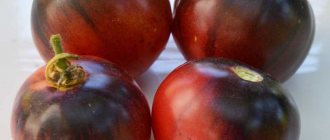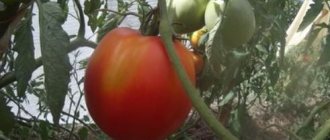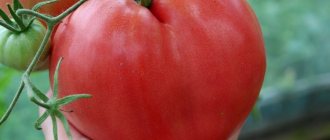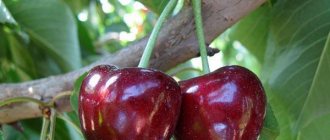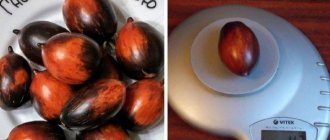The orange oxheart tomato is a variety for those who want to get high yields and have amazingly tasty and equally healthy fruits on the table for 1.5 months. Recommended for cultivation in both warm and cold regions of Russia - in Siberia and the Urals.
| Height | Landing location | Ripening time | Fruit color | Fruit size | Origin | Fruit shape |
| Tall | Greenhouse, Open ground | Mid-season | Orange | Large | Hybrid | Heart-shaped |
Description and characteristics of the variety
The variety was born through the efforts of Russian breeders in 2003. It is an indeterminate hybrid with massive shoots and an abundance of large fruits.
Grows excellently in greenhouses and open beds, on farms and in garden plots. It belongs to mid-season varieties: from the moment of germination to ripening, 125-130 days pass.
The bushes are not standard, the foliage is average. The height of the shoots reaches 1.8-1.9 meters. They require mandatory pinching and shaping. From 5 to 6 tomatoes ripen on a bunch.
The fruits are large. Giants are located on stems of the 1st order, then the tomatoes become smaller. The color is deep orange. The pulp at the break is sugary and juicy. The shape is round, reminiscent of a heart.
The fruits are used to prepare salads, preparations for the winter - juice, ketchup, dressings, pastes.
Characteristics
Tomatoes "Oxheart orange" have the following advantages:
- excellent taste and commercial characteristics of the fruit;
- drought resistance;
- good yield;
- large-fruited.
The disadvantages of these tomatoes include their susceptibility to such a dangerous disease as late blight, and also the fact that they are not suitable for canning.
Bull's Heart Orange tomatoes are characterized by the formation of the first inflorescence above the first leaf. One cluster most often contains five or six fruits. Fruits can differ not only in weight, but also in shape. The largest fruits are usually located on the lower clusters.
You can compare the yield of this variety with others in the table below:
| Variety name | Productivity |
| Bull heart orange | 5-20 kg per bush |
| Bobcat | 4-6 kg per bush |
| Rocket | 6.5 kg per square meter |
| Russian size | 7-8 kg per square meter |
| Premier | 6-9 kg per square meter |
| King of Kings | 5 kg per bush |
| Stolypin | 8-9 kg per square meter |
| Long Keeper | 4-6 kg per bush |
| Black bunch | 6 kg per bush |
| Grandma's gift | 6 kg per square meter |
| Brawler | 9 kg per bush |
On our website you will find a lot of useful information on how to properly grow tomato seedlings. Read all about planting seedlings at home, how long after planting the seeds sprout and how to water them correctly. And also how to grow tomatoes in twists, upside down, without soil, in bottles and using Chinese technology.
Features of cultivation and storage
Greenhouse favorable conditions are ideal for growing. In the middle or end of May, seedlings are transplanted under shelters in cold regions, and in temperate and southern regions - into open beds. It is better to choose light sandy loam soils. Planted at an angle. Add compost and ash to the holes and spill plenty of water.
Avoid crowding, the best distance between bushes is 60 cm, between trenches – 70 cm. There are 3-4 plants per 1 m2. When grown in greenhouses and greenhouses, they are regularly ventilated to prevent late blight.
Conditions for obtaining a high yield:
- watering 3 times a week, except during rainy periods;
- weeding and loosening the soil;
- disease prevention;
- feeding at the stages of vegetation and formation of ovaries - 2 times a month;
- mulching with straw.
If there is excess moisture, the root system dies, the leaves turn yellow, and fungi attack.
Formation is carried out in 1-2 stems. No more than 7 fruiting clusters are left. Pruning is carried out once every 2 weeks.
Tomatoes are not intended for long-term storage. The maximum aging period in dark, ventilated areas is within 10 days - 2 weeks. Transportability is good.
Advantages and disadvantages of the variety
Advantages of the variety "Bull's Heart Orange":
- interesting taste;
- increased content of sugars, amino acids and vitamins;
- high productivity;
- good resistance to diseases and droughts;
- ease of cultivation;
- have good transportability.
As for the disadvantages, the tomato is not suitable for canning. The plant is also often subject to late blight.
Planting and care
Planting is carried out using the traditional seedling method. The optimal sowing time is mid-March. The soil chosen is light, fertile. Mix with compost and ash, add sand. The seeds are kept in a 1% manganese solution for half an hour. It is recommended to disinfect the soil in the box with potassium permanganate.
Seed the seeds to a depth of 2 cm, leaving the same distance between the grooves. Sprinkle a 1 cm layer of nutrient mixture or loose mulch on top.
Water the seedlings with settled water at room temperature and keep the soil moist. You can use a weak solution of mineral fertilizers for watering.
Cover with film until shoots emerge, then remove the covering and begin hardening. The seedlings are kept at a temperature of 15 °C for 7-10 days. Then grown at temperatures of 20-22 °C. They dive when there are 3 true leaves.
Detailed description of the orange variety
Orange Heart tomatoes were bred by Russian breeders relatively recently. They quickly gained recognition among farmers due to their unpretentiousness and excellent fruit characteristics. Resistance to various climatic conditions has made it possible to grow orange tomatoes in all regions, from the south to the north of the country.
Important! The tomato variety “Orange Heart” is popularly called “Liskin Nose” because of the characteristic shape and color of the fruit.
Plant information
Orange Heart tomatoes are indeterminate and heavily leafy. Tall bushes of this variety grow up to 2 meters or more, requiring careful shaping and reliable garter.
It is recommended to form “Orange Heart” tomato bushes into two stems. The experience of farmers shows that this is the method that allows you to obtain maximum crop yield. The process of such formation is described in detail in the video:
The leaves of "Orange Heart" tomatoes are powerful, dark green. They are formed in large quantities on the trunk of the plant. The lower ones must be removed every 10-15 days (3-4 leaves at a time). This will help to properly distribute nutrients in the plant’s body, increase the yield of tomatoes and reduce the likelihood of developing diseases.
The root system of tomatoes is powerful. It requires a large area for its successful development and nutrition of tomatoes, so breeders recommend planting no more than two bushes per 1 m2 of land.
Tomato inflorescences appear every 2-3 leaves. The first of them is formed in the 7-8 sinuses. Each flowering raceme contains 3-6 simple flowers. The ovaries are usually formed successfully, ensuring consistently high yields of tomatoes.
Characteristics of tomatoes
It’s not for nothing that “Orange Heart” tomatoes got their name: their shape is heart-shaped and their color is orange. The correspondence of this description to external characteristics can be assessed by viewing the following photo:
The heart-shaped shape of the tomatoes is complemented by a number of ribs at the stalk and a pointed tip. The skin of these tomatoes is thin and tender. The inner pulp contains a large amount of dry matter and very few seeds. The aroma of vegetables is bright and rich. The taste of tomatoes is dominated by sweetness and there is a subtle sourness.
Important! Experts say that the taste of Orange Heart tomatoes has fruity notes.
Orange tomatoes are heart-shaped and large. Their average weight is 150-200 g. The very first fruits ripen weighing up to 300 g. Tomatoes grown in particularly favorable conditions can reach the same record levels.
Tomatoes with excellent taste characteristics can be used in the preparation of fresh snacks, pasta and winter preparations. Vegetables are also suitable for baby food. The juice from Orange Heart tomatoes is very sweet.
It is worth noting that Orange Heart tomatoes can also be grown commercially. Slightly unripe tomatoes have good keeping quality and transportability. The presentation of such fruits is preserved for a long time.
Crop yield
The ripening period for tomatoes of the “Orange Heart” variety is 110-120 days. This is exactly how much time is needed so that from the day the shoots emerge you can enjoy ripe tomatoes. The fruiting process of the variety is long and, in favorable conditions, can continue until the onset of frost. In open ground, it will be possible to harvest ripe tomatoes of this variety within 40-60 days.
Over the entire fruiting period, each “Orange Heart” tomato bush gives the farmer from 6 to 10 kg of tomatoes. At the same time, the yield indicator can change both up and down depending on external factors, soil fertility, and compliance with growing rules. In general, it is worth noting that the “Orange Heart” variety is very grateful and always responds positively to the care shown by the farmer.
Disease resistance
One of the advantages of the Orange Heart variety is the high degree of protection of tomatoes from common diseases. And many farmers are confident that genetic immunity is able to withstand even the most powerful attacks of viruses, fungi and bacteria. In fact, this is not entirely true, because the immune defense cannot independently cope with aggressive ailments in conditions favorable to microorganisms. That is why you need to remember the following rules:
- Loosening, timely weeding, and mulching the soil are the main preventive methods of disease control.
- Tomatoes should be watered regularly, without allowing moisture to stagnate.
- When planting tomatoes, you need to take into account the recommendations of crop rotation.
- The optimal conditions for the growth and fruiting of tomatoes are a temperature of +23-+260C and a humidity of about 50-700C. To maintain such a microclimate, you need to regularly ventilate the greenhouse.
- To prevent diseases, you can use special biological products or folk remedies. For example, in the fight against common late blight, you can use fungicides, copper-containing preparations or iodine solution.
- To combat pests, you can use herbal infusions (celandine, wormwood), ammonia solution or soap solution.
When growing Orange Heart tomatoes, it is worth remembering that only a set of preventive measures in combination with the natural immunity of this variety will help protect plants from the most common and dangerous diseases. At the same time, regular and thorough inspection of the bushes, if necessary, will help to quickly detect the problem and eliminate it.
Advantages and disadvantages
Tomatoes of the proposed orange variety have a lot of significant advantages, which include:
- Excellent taste and aroma of tomatoes, their meatiness.
- Original appearance of tomatoes.
- High content of vitamins, acids, minerals and fiber in the product.
- Good yield of vegetables.
- Transportability of tomatoes and their suitability for long-term storage.
- Genetic resistance to diseases.
- The variety is highly sensitive to fertilizing, which allows you to further increase crop yield.
The only drawback, or rather a feature of the variety, is the need to form indeterminate bushes, regularly removing stepsons and powerful lower leaves from them. It is worth noting that this feature in care is typical for all indeterminate varieties.
